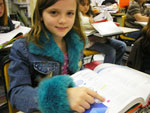At a Glance
Teacher Review
Topics
Website
Features
Duration
Grade(s)
Lesson Format
Download
My History at School
Access 7 activities which introduce the evidentiary and narrative aspects of history to young students. Students familiarize themselves with these topics by exploring their own past school experiences.
Review

This collection of activities found on the Bringing History Home website introduces first graders to important historical concepts. Through exploring the history of their time at school, students learn about topics such as chronology and historical context as well as how to identify and question different types of primary sources. While these concepts may seem fairly sophisticated for first or second graders, the activities introduce them in accessible and engaging ways. There are seven activities that make up this instructional unit. Each activity can stand alone as a single class lesson or can be combined with others for a multi-day lesson or unit. The first activity asks the question, "What is history," and distinguishes between fictional stories and stories about things that actually happened. Understanding history as a story is a central theme throughout the plan, and the subsequent activities focus on the centrality of evidence in creating historical stories.
Activities three, four, and five introduce students to various types of evidence historians use to make sense of the past, through examining school artifacts such as a newsletter and cafeteria menu. In the final activity, students work as a class to construct a mind map about the history of their year at school. Students are then asked to draw a picture that illustrates one of the concepts from the mind map. Finally, students can be assessed by asking them to identify types of evidence that can provide particular types of information about the school. With a focus on making connections to students' experiences and teaching them that history is a story based on evidence, these clear and kid-friendly activities are an elegant way to introduce key aspects of history to young elementary students. Designed for first graders, these activities can be useful for both younger and older students.
Notes
| Field | Criteria | Comments | ||
|---|---|---|---|---|
| Historical Content | Is historically accurate? | Yes |
||
| Includes historical background? | Yes |
|||
| Requires students to read and write? | Yes |
|||
| Analytic Thinking | Requires students to analyze or construct interpretations using evidence? | Yes |
||
| Requires close reading and attention to source information? | Yes |
|||
| Scaffolding | Is appropriate for stated audience? | Yes |
||
| Includes materials and strategies for scaffolding and supporting student thinking? | Yes |
|||
| Lesson Structure | Includes assessment criteria and strategies that focus on historical understanding? | Yes |
||
| Defines clear learning goals and progresses logically? | Yes |
|||
| Includes clear directions and is realistic in normal classroom settings? | Yes, but no estimated times are provided for instruction. |
|||